#National Graves Association
Explore tagged Tumblr posts
Text
#OTD in 1831 – Jeremiah O’Donovan Rossa is born in Rosscarbery, Co Cork.
Jeremiah O’Donovan Rossa was born in a small village called Reenascreena near Rosscarbery, Co Cork. He was the son of a tenant farmer, Denis O’Donovan and his wife Nellie O’Driscoll. While a young boy, the failure of the main food crop of the Irish population which was the potato, in successive years between 1845 and 1847 led to a devastating hunger which hit the West Cork area in which he lived,…
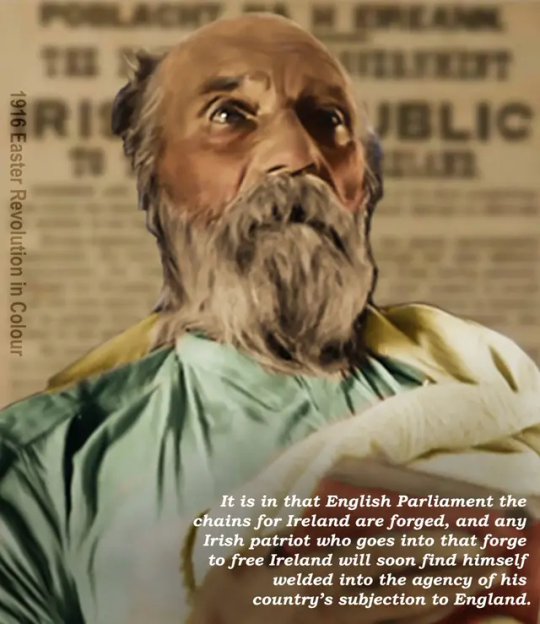
View On WordPress
#Co. Cork#Dublin#Fenian#Funeral Oration#Glasnevin Cemetery#Glasnevin Trust#Jeremiah O&039;Donovan Rossa#John Devoy#National Graves Association#Nationalist#NY#Padraig Pearse#Reenascreena#Rosscarbery#St. Vincent’s Hospital#Staten Island#Tom Clarke
12 notes
·
View notes
Text
Revolutionary Girl Utena: Gender in Context
beneath the cut, I discuss the RGU's portrayal of gender in the context of 1990s Japan.
in Ikuhara's interview with Mari Kotani, he stated that in traditional Japanese society, "prince" meant "patriarch." the same is true in Western societies--there was a time when a prince would be an heir to a royal line. by 1997, this meaning had died out of large parts of the world. even the association between princes and traditional masculinity was fading. Saionji, the weakest, most pathetic man in the show, is a parody of historical Japanese masculinity, with his kendo and his blatantly regressive beliefs about women.
in RGU, prince may still mean patriarch, but in a far more subtle fashion. Ikuhara and Kotani discussed the changing expectations for men in the latter half of the 20th century--it became gauche to fight over a woman with one's brawn, so instead, power struggles were played out in the arena of looks and sex appeal. one can see this reflected in the character Akio, whose power as a prince arises from his ability to turn "easy sensual pleasure based on dependency" "into a selling point with which to control people."
Akio has his moments of showboating masculinity, but when preying on Utena, he operates by making himself seem non-threatening and soft.
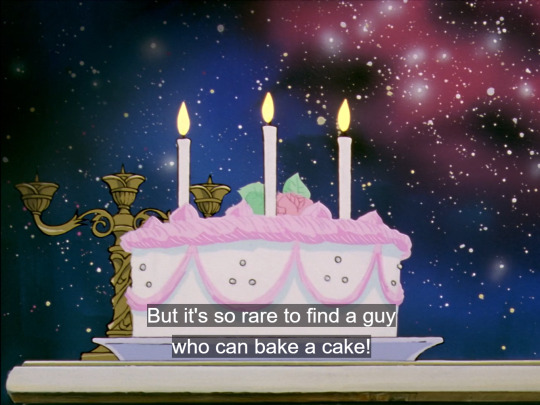
not only that, but he purports to want to allow students to express their individuality and thus approves of Utena's masculine form of dress. this is a front--by the end of the show, he's telling Utena that girls shouldn't wield swords. thus, through Akio's character, the show argues that traditionalist patriarchy in Japan isn't gone, but instead has only been papered over with false progressivism.
with all that said, there seems to be more to the character. he's taken the family name of his fiance, Kanae, and whatever material power he has in the school is dependent upon her family. in Japanese society, this is considered a humiliating position to be in, something that only a shameless man would do. the show never gives the audience any insight into how Akio feels about this--is he unbothered entirely, or are his actions against the Ohtori family an expression of his repressed anger? does he harm the children under his care to compensate for his humiliation?
this aspect of Akio's character may seem irrelevant in light of the larger, immaterial social forces at work in the show. however, I would argue that it was included for a reason. Akio, despite his status as ultimate patriarch of Ohtori, is in fact a highly emasculated character, to the point where lead writer Enokido even said that he is driven by an infantile mother complex.
to explain why Akio was portrayed this way, we have to discuss Japanese history. the nation suffered a major defeat in WWII and was forced to accept whatever terms the United States laid out for it. for an examination of how the Japanese have never truly processed those events and have plunged into modernity with reckless abandon, I recommend Satoshi Kon's Paranoia Agent. to sum it up briefly, in a very short period, the nation regained its economic footing, and by the 1980s had the largest gross national product in the world. this economic boom may have allowed Japan to maintain a sense of sovereignty, dignity, and power, but it was inherently fragile.
the infamous "bubble economy" lasted from 1986 to 1991. during this time, anything seemed possible; financial struggles appeared to be a thing of the past, and capitalist excess reached new heights. the ghosts of this period can be felt across Japanese media; for instance, think of the final shot of Grave of the Fireflies (1998), where the two dead children look down on Kobe, glowing an eerie green to imply its impermanence. the abandoned theme park from Spirited Away (2001) is explicitly referred to as a leftover from the previous century, when many attractions were built and then tossed aside in a few short years.
the bubble popped in 1992, leaving an entire generation feeling cheated. the bright futures they'd been promised, which had actually materialized for their parents and older siblings, had been lost to them overnight. economic crises are often accompanied by gender panics. to quote from Masculinities in Japan, "The recession brought with itself worsening employment conditions, undermining the system of lifelong employment and men’s status of breadwinners in general. The unemployment rate was rising, and although it never reached crisis levels, men could no longer feel safe in their salaryman status. Their situation was further complicated by the rising number of (married) women entering the workforce."
with this in mind, Akio's character can be taken as a representation of masculinity in crisis in 90s Japan. he's forced to rely on women for his position in life and has failed to save his only relative, Anthy. he tries to escape his misery through hedonism, perhaps an allegorical representation of how men tried to maintain their old standard of living after the economic bubble burst.
but of course, Akio is not the main character of RGU--the story is about girls. mangaka Yamada Reiji discussed the series in the context of the 90s, stating the following:


while I opened this essay by discussing the prince, the same points could be made about the princess. despite the increasing irrelevance of royalty, princess is still an important concept. how does it relate to the socioeconomic landscape of the 90s?
in Yamada's view, RGU is full of relics of the 80s; for instance, the figure of the ojou-sama, an entitled young woman who never lifts a finger for herself. during the economic bubble, it was increasingly common for women to be entirely taken care of by the men in their lives. Yamada names Nanami as a clear ojou-sama type character: she weaponizes her femininity, demanding to be rescued, doted on, and served.
however, by 1997, the ojou-sama could no longer expect to get what she wanted. from the 80s to the 90s, the percentage of women in the workforce increased around 15%; it was no longer viable for most women to be "kept" by their families. as the men experienced the humiliation of not being able to provide for their wives and children, women were undergoing a disillusionment of their own.
Yamada blames Disney for creating the ideological structure which led women astray. obviously, the company is known for its films about princes rescuing princesses. in Yamada's recounting, during the 80s, the company was infiltrating Japan through its theme parks as well; across the country, Disneylands were opening up, and people were buying into the escapism the corporation offered. Japan, as America, became a country of eternal children. its people were waiting for a prince to appear and save them.
but fairy tales can't stave off reality forever. Yamada claims that RGU embodies the rage of young women who woke up one day and realized that they had been raised on a lie. this anger pervades the work from beginning to end.
though RGU was created in a particular social context, its lessons can be extrapolated to any time and place. as the first ending tells us:
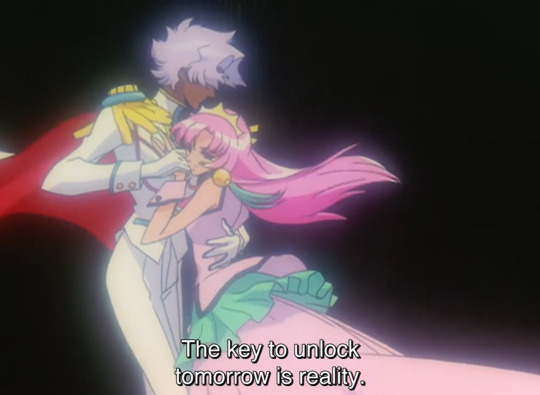
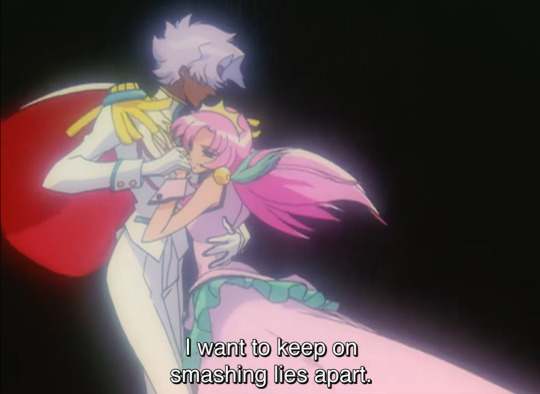
I hope this essay helped provide more context for the series. thanks for reading!
#rgu#commentary#revolutionary girl utena#this was originally a part of another essay but i revamped it and added a lot more detail
828 notes
·
View notes
Text
Mamabat 10 part 1/2
Chapter 10 : Calling from Hell just to say the demons are suspiciously absent, is that fine?
masterpost
“Fucking Batman,” Val said under her breath. Her Red Huntress mask muffled the words and made them come out even meaner than she probably meant them. “Years late and too little, even if he’s not working with the GIW.”
Sam hefted her requisitioned Fenton bazooka and pressed her lips even further together. None of them liked this at all. It stank. It was suspicious. Danny hadn’t sounded distressed, but he’d been out of contact too long for such a short conversation to put her at ease. There hadn’t even been time to update him on what had gone on in Amity Park.
“There.” Sam followed Val’s pointer finger to see the nearly invisible outline of a jet in the faint light. It was landing in the right field.
“It’s them or it’s a trap,” Sam muttered.
Val let out a mean laugh. “If it’s someone we don’t expect, they’re the ones in trouble.”
Sam huffed and said nothing. She couldn’t disagree, but Val seemed too confident for her comfort. They waited in tense silence to see the jet come to a landing. Not long after, a hatch popped open and the distinctive ears of Batman himself were the first out into the cold night air of a January night in Amity Park.
He was quickly followed by smaller figures- 1, 2, 3 of them. Sam felt nerves churning in her gut. She tried to channel them into aggression. She had to be tough, tougher than usual. There was no cavalry waiting to help out.
Well, there was Tucker, but he was probably going to be more useful in the wings to feed them information. He was pretty good aim with a thermos but that wouldn’t do jack about Batman and a small flock of, what, junior associates?
“Does Batman work with children?” Sam asked under her breath. One of them was genuinely small.
Tucker snickered on the other end of the line. “Uh, there’s supposed to be a Robin. Guy in yellow, green, and red I guess? Aside from that, there’s debatably like, 6 former Robins associated with him. But there’s also the Justice League’s junior varsity team, so it’s hard to say.”
She frowned at the lineup. She saw purple, black, and red. There was- yeah, okay, there was quite a bit of yellow when the little guy faced them, but she didn’t see any green.
“Showtime,” Val said. Sam crouched further behind cover as the other girl zoomed out on her hoverboard, effortlessly drawing Batman’s eye. She adjusted the dial on her sound settings to hear Val’s feed just a little louder.
“Batman.”
“You have me at a disadvantage.” Sam cringed at the gravely voice over her sound system. Batman sounded like he smoked a pack a day. She turned the volume down just a hint.
“Not really, there’s four of you,” Val said breezily. Sam suppressed a snort at the dodge. “You wanna meet Jazz Fenton? You’re going to have to prove that you’re not a plant. There’s a GIW facility-”
“Two miles west of here, yes,” Batman interrupted. “I researched.”
“Great. Do you have ground transport?”
“Of course. What is it that you expect me to prove?”
“That you’re not with them.” The subtle whine of Valerie’s weapons started up. Sam only heard it because she was hooked up to the helmet. “They do experimentation and keep prisoners. Show me that you’re not a cop.”
“The police would not support the capture and abuse of people.”
Valerie made a skeptical sound in the back of her throat. Sam couldn’t blame her. “Yeah, but they do.” Her hoverboard’s jet whooshed up in power. “Meet me there, outside the main gate.” She was off like a shot in the dark.
The four out of towners didn’t take long to get four silent motorcycles out and dash down the lane. Sam thought about what she’d heard as she cut a more direct route on Valerie’s spare hoverboard, taken from Vlad’s deserted mechanics lab.
Either Batman was a liar, naive, or he was exactly what they were worried he might be. The Justice League was famously affiliated with governments. Wonder Woman was even a member of the United Nations! If someone accepted the claim that Infinite Realms Residents weren’t really people, then they’d say just what Batman had. It wasn’t lying if you didn’t think the people you were hurting were really people.
Sam watched from a distance as the group reached the gated facility. One of Batman's people did something that unlatched the electronic security system. It swung open.
“Not shabby,” Tucker said quietly. “I coulda done it faster.”
“Not unless it goes off the rails,” Sam reminded him. She clenched a fist against her thigh. They needed to see Batman's real colors before they risked him knowing about their group. It was hard to outplan what you didn't know about, and they'd need every advantage they could get.
She let them all go ahead before she followed onto the property. It was eerily deserted, tire tracks where dozens of white Vans ought to have been.
The GIW had deserted Amity Park weeks ago. They were pretty sure there was a skeleton crew stationed out here, but no one came and left anymore. They only occasionally saw an agent wander across the path of a security camera, which were sparse inside the building.
But that didn't mean it wasn't dangerous to be here. Even now, a camera swiveled over the lawn, blinking a clear light that was easy to miss during the day. There was a reason that they hadn't risked a second raid after Danny had barely made it out last time.
Sam swallowed, hard. The bitterness in her mouth felt a lot like guilt. Who knew what the GIW had been doing? They could have someone else held captive. It was a big building. Danny might have missed someone when he was breaking Vlad out.
‘We did what we could, and we are making a move now.’
She repositioned her weapon and waited, tense with nerves. All she was meant to do now was follow along via what she heard on Val's comms and be in the wings to facilitate an escape, if needed.
“Left,” said Batman quietly. The comms were quiet for a long moment, then- “clear. Clear. Clear.”
Sam shifted her weight from one foot to the other.
“Red Robin.”
“Got it,” came a response, barely audible. Val must have been hanging close to Batman, then.
“You think now's a good time to try their computers?” Val said helpfully.
Tucker snorted. “Could just ask,” he sang to himself, cocky as hell. “I know all.”
Sam rolled her eyes. He didn't know all. About half of the property was disconnected from the security system, meaning they had no eyes on whatever was down there.
“Six stationed here.”
That had to be Red Robin’s voice. Sam cocked her head and focused on it, frowning slightly. Did it sound young?
Tucker's computer chair made a click when he sat up too fast. “Wait, what? How'd-” His end of the line devolved into rapid typing.
“Did you find a schedule?”
“No, it's not in the system. They're on paper, I suppose.” Seconds passed. “My bet is that labs would be in this wing.”
“Be my guest,” Val drawled. Sam could all but see her crossing her arms across her chest.
The line went silent for a while. Then, faintly, there came the sound of a metal door opening.
“Fu-” A GIW blaster went off. “Intru-”
The alarm was cut off before the GIW goon got out a full word, but odds were good he'd been heard anyway. Sam flexed her hands. Sitting this out sucked. She wanted to see what was happening. How many agents were there?
“Robin!” Batman snapped.
‘The little one?’
Sam felt vaguely ill. They had to be okay. This was Batman’s team.
572 notes
·
View notes
Text
if you want an illustration of the extent to which the anc in south africa has degenerated from its heroic period: for the last 3mo it has, to hold onto power, governed thru a coalition including not just the generically white Democratic Alliance but the inkatha freedom party and freedom front plus. the former is a conservative black party with deep historical ties to the bantustan system and with which the anc was engaged in literal open warfare during the 90s, to the point mandela would use association with them to tar the previously hegemonic and apartheid-based national party(!!); the latter is a far right whiteafrikaner nationalist party to emerge from racist elements of the apartheid-era military during the transition to full political democracy; both parties earned <4% of the vote share in this years elections each. all of this compromise with the remnants of the prior regime to suppress the influence of left-wing parties like the eff and mkp favouring large scale economic redistribution in the most unequal country in the entire world. (of individually owned land, the black supermajority of the populations owns a whopping four percent.) whatever one thinks about either party or its leaders, its hard to argue they are either of them less aligned with the founding spirit of the african natl congress than the ifp or ff+, the heirs to the military and paramilitary factions that made it their business to drown the anc in blood during its foundational struggle
this might seem bleak, but in reality it points a novel way forward for one of the most prominent and distinctive political problems in contemporary south africa, that of so called "load shedding" or (less euphemistically) rolling blackouts by eskom, the state-owned power company responsible for most electricity generation and distribution in the country. simply hook up a rotor between eskoms generators and nelson mandelas grave and soon enough you should have enough power 24/7 to blind any astronauts looking down at the southern tip of the continent
242 notes
·
View notes
Text
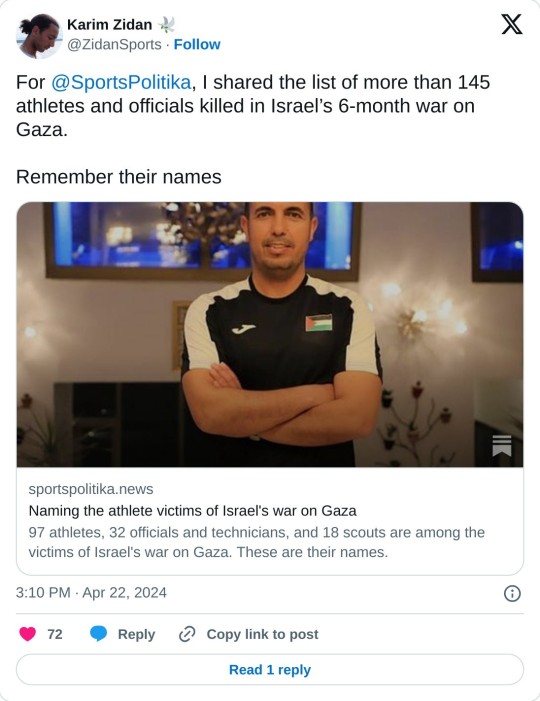
On Monday, April 15, the Palestinian Football Association announced that three children from the Al-Wahda Sports Academy had been killed during Israeli raids in Deir al-Balah, located in the heart of the Gaza Strip. “We announce the martyrdom of players Sami Bilal Abu Issa and Muhammad Bilal Abu Issa,” Al Wahda Academy announced on its Facebook account, which followed up by announcing the death of Adam Ramez Nabhan in another Israeli bombing. “Our hearts break for their loss.” The three children—the youngest of whom was was four years old, with the other two aged six—are among the hundreds of Palestinian athletes who have been killed since the war broke out between Israel and Hamas on October 7, 2023. Later that same day, the PFA revealed that at least 182 athletes and sports officials had been killed amid Israel’s destruction of Gaza, including no less than 28 children. An overwhelming number of the athletes killed were members of Gaza’s once vibrant football ecosystem. Among the notable names is Hani Al-Masdar, a former player and manager of the Olympic team, and Mohammed Barakat, Gaza’s first centurion of goals and a former national team player known as the “Legend of Khan Younis.” Israel has also destroyed or partially dozens of football facilities in Palestine since the start of the war. These include all of Gaza’s professional football stadiums, as well as the PFA headquarters, which was also targeted by Israeli airstrikes. Meanwhile, smaller facilities and dirt pitches have been transformed into makeshift refugee camps, field hospitals, and mass graves.
You can find the entire list of athletes murdered or injured by Israel in link above
#yemen#jerusalem#tel aviv#current events#palestine#free palestine#gaza#free gaza#news on gaza#palestine news#news update#war news#war on gaza#gaza genocide#genocide#football#footballer#soccer#athletes#palestinian athletes
350 notes
·
View notes
Text
Waylon "Lance" Gardner ~ Shadow Company OC

Brief introduction to my Shadow Company OC, Lance! He used to be part of Vana’s fire team in the Marine Corps but joined Shadow Company after Hassan’s death. He and Vana have a strained relationship now, especially after she began to associate with Task Force 141. Graves’ betrayal only made things worse.
Expect more on him in the future~
~ ~ ~
Name: Waylon Gardner
Alias: Lance
Sex: Male
Nationality: American
Age: 32 years
Height: 6’1”
Occupation: Private Military Contractor
Affiliation(s): US Marine Corps (formerly), Shadow Company, KorTac
Face Claim: Bailey Chase
~ ~ ~
Art by mrg__dm on Instagram! Go get a commission from them, their art is gorgeous❤️
#my oc: waylon lance gardner#my oc#original character#oc#call of duty oc#cod oc#call of duty#cod#call of duty modern warfare#shadow company#commission
190 notes
·
View notes
Text
April 20, Beijing, China, National Museum of China/中国国家博物馆 (Part 5 – Ancient Chinese Porcelain exhibition/中国古代瓷器展):
First post of the year, gotta start with something good: this is a rather famous vase from Qianlong era of Qing dynasty (1644 - 1911). It's made in the suantouping/蒜头瓶 (lit. "garlic-head vase") shape, and decorated with falangcai/珐琅彩 (basically cloisonné but done on porcelain instead of metal). The design features a nice combination of traditional Chinese chanzhihua/缠枝花 motifs (traditionally this continuous plant motif symbolizes longevity) and European art influence, specifically from rococo. This is interesting as rococo was also influenced by Chinese porcelain, making this vase another example of cultural influence going both ways.

As mentioned in my previous announcement post, my visit to the National Museum of China was very brief, everything took place in the span of one day (plus traveling to and from Beijing), please pardon the picture quality.
And from here on I will be going in chronological order. Below is an urn from the Northern Dynasties (439 - 581 AD). This urn was decorated with lotus petals all around, and was specifically a type of grave good, not made to be used by the living. Lotuses are a commonly used symbol in funerary rites due to its association with Sukhavati (Sanskrit: सुखावती; referred to as "极乐世界" or "Land of Bliss" in Chinese) in Mahayana Buddhism.

Another urn, this time from the Sui dynasty (581 - 618 AD) Shouzhou kiln/寿州窑. This urn may also have been grave good, as evidenced by the numerous Buddhist symbols all around.

Left: a small Sui-era vessel, found in a tomb. It's probably also a grave good, because of its pointy design (imagine holding that).
Right: a group of small Sui-era grave goods, these were tiny and adorable


In the middle is a Tang dynasty (618 - 907 AD) pitcher, made by the Lushan kiln/鲁山窑. This pitcher displays Lushan wares' characteristic blueish glaze, where the blue comes from different concentrations of iron oxides.

Left: a Northern Song dynasty (960 - 1127) white-glazed wine vessel called a meiping/梅瓶 (lit. "plum vase"), but in Song dynasty it was called a jingping/经瓶.
Middle: a Northern Song era white-glazed Ding ware/定窑 plate decorated with the double fish motif.
Right: this one is pretty cute, it's a container for weiqi/围棋 pieces that's shaped like a drum, made by Yaozhou kiln/耀州窑.



Left: forgot to take a picture of the placard, but my guess is that it's a bamboo-necked celadon-glazed Longquan ware/龙泉窑 vase (I might be wrong).
Right: a small Southern Song dynasty (1127 - 1279) Ge ware/哥窑 bixi/笔洗. Bixi are containers used to rinse traditional brushes. This bixi has the crackled glaze that's characteristic of Ge wares.


Left: a small haitang/海��� flower-shaped celadon-glazed lidded container box called a taohe/套盒, made by Southern Song dynasty guan kiln/官窑 (guan/官 means "official", so "guan kiln" is best understood as the kiln that's run by the imperial court; this is important as later dynasties may have their own guan kilns). These containers can hold various small objects including food, and are stackable.
Right: a Song-era haitang-shaped rose purple flower pot, made by Jun kiln/钧窑. Jun wares are known for their glaze colors, which shift and change according to the firing temperature, this is known as yaobian/窑变 (aka kiln transmutation or "flambé"). This particular flower pot became part of Qing imperial court's collection later on.


A Yuan dynasty (1206 - 1368) qinghua/青花 ("blue and white") porcelain pot, decorated with dragons. The blue color in the famous qinghua porcelain comes from cobalt blue pigment in the underglaze.

A Yuan-era qinghua porcelain vase decorated with a flying fenghuang:

Two Ming dynasty (1368 - 1644) tall-footed bowls, the left one has a glaze known as "sweet white glaze" (甜白釉), since this shade of white was likened to the white of crystal sugar; the reign mark indicated that it was made during the Yongle era of Ming dynasty. The bowl on the right has the peacock blue glaze (孔雀蓝釉), and the reign mark indicated that it was made during the Xuande era of Ming dynasty. Reign marks are markings that indicate the dynasty and era during which a piece was made.

A side note on era names or nianhao/年号: nianhao was a way of identifying years in imperial China and was usually decided by the reigning emperor at the time. One emperor may have multiple era names during their reign if they so choose, however since Ming and Qing dynasty mostly have just one era name per emperor, Ming and Qing emperors are often referred to simply by the era name they used, for example Yongle Emperor (temple name Emperor Chengzu of Ming) or Qianlong Emperor (temple name Emperor Gaozong of Qing). Depending on the context, usage of a Ming or Qing era name may refer to the time period during which an emperor reigned, the emperor who used the era name, or even both.
Three Ming-era monochrome (called danseyou/单色釉 in Chinese) porcelain plates. Monochrome porcelain became popular in Song dynasty, and has been popular ever since, but overall three dynasties were the most famous for their production of monochrome porcelain: Song dynasty, Ming dynasty, and Qing dynasty (1644 - 1911). Recently monochrome porcelain has been gaining popularity again, since their vibrant colors fit into modern aesthetics surprisingly well.

A wall of monochrome porcelain plates, illustrating the effect of different elements and firing temperatures on glaze color.

A set of wares that may be found in a study, made in the Kangxi era of Qing dynasty (1662 - 1722). The glaze used here is quite famous, called jiangdouhong/豇豆红 (aka cowpea red), created by applying copper red glaze in high temperatures. The end result is notoriously hard to control, so some pieces may turn out to have multiple colors, mostly the shade of red as seen below and apple green. The left and back pieces are both small decorative vases (for the longest time I thought the one on the left was an upside-down bowl......lol), the small box in the front is a seal paste box, and the flat bowl on the right is a bixi.

Left: red and blue yaobian vase, made during the Yongzheng era of Qing dynasty (1723 - 1735); unfortunately due to the angle here, you can only see a little bit of the blue streak running down the front. The colors are so vibrant here that this kind of yaobian has earned the nickname of "flaming red"/火焰红.
Right: a langyaohong/郎窑红 (also called "sang de boeuf" or "oxblood") vase, made during the Kangxi era of Qing dynasty. Langyaohong glaze is known for its deeply red color, hence the names that relate it to blood.

A Kangxi era blue glazed gilt porcelain vase. I love the intricate interconnected lotus patterns (chanzhilianwen/缠枝莲纹) here. I didn't have time to take a picture of the placard so it literally took hours of pulling my hair out reverse image searching to find out when (which era) this vase was made................. (btw the text in the back refers to the painting in the background, not this vase)
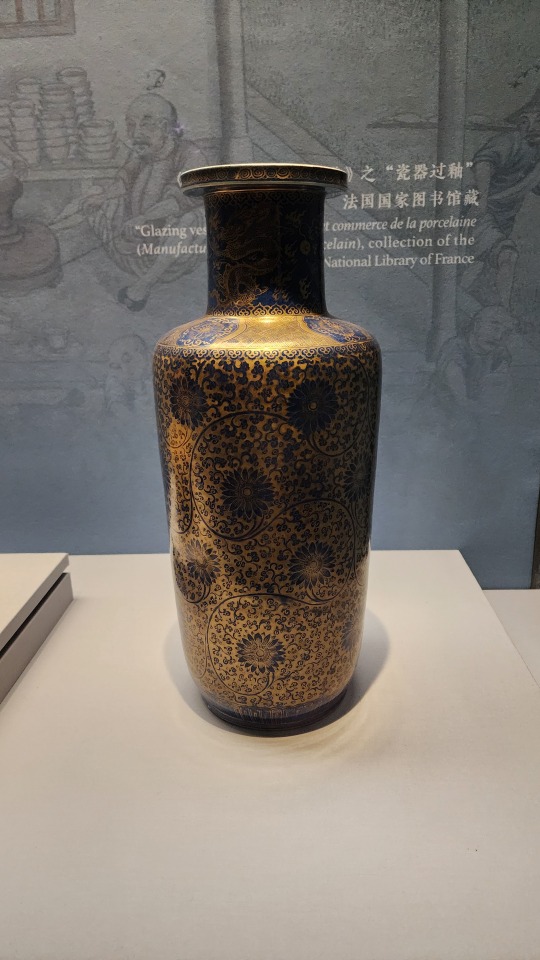
Left: a youlihong/釉里红 vessel that's shaped like an apple, so it's quite literally named a pingguozun/苹果尊. This shape is rather unique to the Kangxi era. Youlihong (lit: "red inside glaze") is basically a red copper oxide underglaze.
Middle: a youlihong vase made in the Yongzheng era.
Right: a larger vase made in the Yongzheng era that combines qinghua underglaze and youlihong underglaze in one piece.

This giant qinghua vase from the Qianlong era of Qing dynasty (1736 - 1795) was made in the shape of Shang and Zhou dynasty ancient bronze ritual vessel named gu/觚. This is also one of the few pieces produced in history that had the name of the potter attached to it. The potter who made this vase was Tang Ying/唐英, and he was the superintendent who oversaw imperial porcelain production in Jingdezhen/景德镇 (basically the Ming and Qing dynasty guan kiln) during the Yongzheng era and the Qianlong era. Together with the Kangxi era, these three Qing dynasty eras are collectively called "清三代", or "the three Qing generations (of emperors)", this was the second height of porcelain making in Chinese history after the "five great kilns"/"五大窑" of Song dynasty.

A column shaped openwork fencai/粉彩 incense holder from Qianlong era, where fencai is basically overglaze enamel decoration that falls under famille rose.

Left: a Qianlong era green fencai vase that feature kaiguang/开光, which were window or panel-like designs on the piece where scenes may be painted. This particular vase also displays poetry by Qianlong Emperor himself.
Middle: a fencai shuanglianping/双联瓶 made during the Jiaqing era of Qing dynasty (1796 - 1820). Shuanglianping are conjoined vases that symbolize the coming together of matching talents or generally good things.
Right: a Qianlong era gourd-shaped doucai/斗彩 vase with kaiguang. Doucai combines both underglaze decorations and overglaze decorations.

I want to draw special attention to this leaf-shaped fencai cup in the middle that was made in the Guangxu era of Qing dynasty (1875 - 1908). The "leaf" part is actually a lotus flower, but the cool thing about it is that the green stem part is a built-in straw, so this is a highly decorative porcelain straw cup. I really do hope there are cheaper modern replicas of this cup sold somewhere, I want one
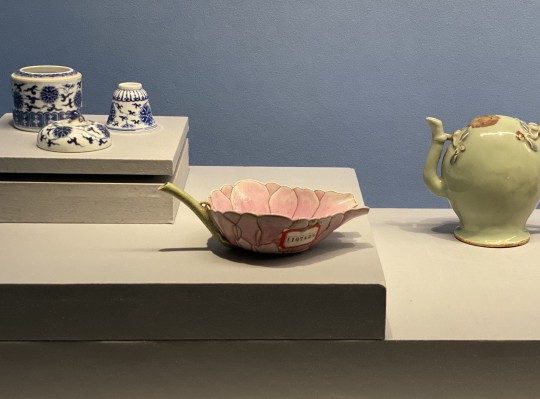
Finally, to wrap up this exhibition, here's an arrangement to show how these different porcelain pieces would be utilized in a traditional study room.

#2024 china#beijing#china#national museum of china#chinese porcelain#chinese art#chinese history#chinese culture#porcelain#ceramics#art#culture#history
95 notes
·
View notes
Text

In 2017 I interviewed Bernadette Wren, then head of psychology at the Tavistock Gids clinic, and asked what effect puberty blocking drugs have on the adolescent brain. Looking highly uncomfortable, she replied that the evidence so far was only anecdotal but that the clinic would study its patients “well into their adult lives so that we can see”.
Even back then, before whistleblowers had exposed the rush to medically transition children, it was alarming to hear that heavy-duty GnRH agonists such as triptorelin — used to treat advanced prostate cancer and “chemically castrate” sex offenders — were being prescribed to arrest puberty in hundreds of children as young as 11.
Moreover, they were being used “off-label” before any clinical trials. And the long-term study Wren promised never materialised: Gids (the Gender Identity Development Service) routinely lost touch with patients, and the 44 it did follow reported little long-term mental health improvement.
This shocking chapter in medical history, where the ideological objectives of trans rights campaigners trumped the welfare of disturbed children, is coming to an end worldwide. The decision by NHS England effectively to ban the prescription of puberty blockers comes after the Cass review noted these drugs could “permanently disrupt” brain development, reduce bone density and lock children into a regime of cross-sex hormones requiring life-long patienthood.
NHS England unites with other national health services including those in Finland, France, Sweden and, most notably, the Netherlands — where the “Dutch protocol”, a regime of early blockers then hormones, was devised in 1998 — in pulling back from prescribing them.
Even in the United States, where a toxic combination of extreme activism and medical capitalism has pushed child gender medicine to grotesque extremes, with double mastectomies performed on 14-year-old girls, there is some retrenchment.
Leaks from the World Professional Association for Transgender Health, the body which formulates guidance on “trans healthcare”, reveal doctors perplexed at how they should explain to an 11-year-old child that drugs will render them infertile. Crucially, liberal media such as The New York Times are now reporting grave medical misgivings about child transition, once dismissed as a culture-war issue for the Republican right.
Yet the question remains: how was this ever allowed to happen? For years, puberty blockers were cheerily billed as a mere “pause button”. In 2014, Dr Polly Carmichael, the last head of Gids before the Cass review ordered its closure, went on CBBC in a show called I Am Leo, saying of blockers: “The good thing is, if you stop the injections, it’s like pressing ‘start’ and the body carries on developing as it would if you hadn’t started.”
The BBC permitted her to make this unevidenced claim to an impressionable audience of six to 12-year-olds. Imagine hearing this as a developing girl, freaked out by your new breasts and periods. No wonder Gids referrals subsequently rocketed.
Carmichael failed to mention that she did not know if pressing “restart” on puberty is always medically possible — it is not — and in fact, almost every child Gids put on blockers went on to irreversible cross-sex hormones.
After years in a Peter Pan state while their peers developed, they understandably felt there was no way back and forged on with treatment. Yet if allowed to experience natural puberty, almost 85 per cent of gender dysphoria cases resolve themselves.
Nor did Carmichael tell CBBC kids that the blockers-hormones combination, if taken early enough, not only results in sterility but kills the libido so that a young person will never experience an orgasm.
At the 2020 judicial review brought by a former Tavistock clinician and Keira Bell, the brave young detransitioner rushed onto hormones by Gids, judges expressed astonishment at Gids’s lack of an evidence base.
Reporting on this issue for seven years, I too have been struck by a complete clinical incuriosity. Not only was data not collected, but those who queried treatments or pressed for evidence faced angry condemnation. Perhaps activists knew what research might find because one long-term Finnish study, recently reported in the BMJ, destroyed the myth used to justify blockers: that a child will commit suicide if denied them.
The Finns found that “gender-affirming care” does not make a dysphoric child less suicidal. Rather, such children had the same suicide risk as others with severe psychiatric issues. In other words, changing bodies does not fix troubled minds.
Yet even after NHS England’s announcement, activists refuse to heed the now-overwhelming evidence. In its response, Stonewall persists with the myth that puberty blockers “give a young person extra time to evaluate their next steps”.
Many questions remain unanswered: will private clinics still be permitted to prescribe puberty blockers; and is Scotland’s Sandyford child gender clinic still determined to close its ears to all evidence? Plus, we have few details on how the NHS’s new “holistic” treatment for gender-questioning children will operate when it opens next month.
This repellent experiment — in which girls who like trucks or little boys who dress as princesses, and who invariably grow up to be gay, are corralled inexorably down a road towards life-changing treatments — belongs in the book of medical disgraces. As do the cheerleaders who raised money for Mermaids and those who persecuted whistleblowers or damned journalists asking questions as transphobic.
In 50 years, chemically freezing the puberty of healthy children with troubled minds will be regarded with the same horrified fascination as lobotomies — which, never forget, won the Portuguese neurologist Antonio Egas Moniz the 1949 Nobel prize.
--------------------
{Article source (behind paywall)}
242 notes
·
View notes
Note
odd question: did the norse people ever worship or venerate the warriors of Valhalla? or was it just a goal to aspire to?
The Old Norse people worshipped their ancestors, some of which went to Valhalla, and some who were definitely heroes. But I don't think they worshipped "the warriors of Valhalla" as an archetype, or as paragons to emulate. Valhalla wasn't even viewed as a goal to aspire to. Rather, it was a consolation prize for dying far from home.
Prior to the Viking Age, the Norse people believed they rejoined their family and ancestors after they died. However, this was dependent on the fact they would be buried in the family grave or barrow.
But going a-viking meant risking death far from home, and this death would most likely happen while out at sea or during a skirmish.
In order to reconcile the question of "Where do we go if we can't be with our families?", the Norse people concluded that if they died out at sea, they went to Njord's hall, and if they died in a skirmish, they went to Odin's or Freyja's hall. This way, they had the comfort of knowing they would still be with their gods and people if they perished far from home.
It's important to keep in mind that the vikings were not exactly a warrior class; as in, "being a warrior" wasn't their job. They were pirates. And like all pirates, their goal was to retrieve goods, either by trade or by raid. Most vikings had every intention of making it home alive, and just like being a skilled sailor improved these odds, so did knowing how to put an axe through a man's skull.
Dying while going a-viking was honorable for the same reason that successfully returning home with goods was honorable; it's the fact that a person risked their life to travel very far away and gather resources for their family and community. It's an honorable deed.
But just because this death was honor-worthy doesn't mean it was a goal.
First of all, let's consider the practical aspect here: In a pre-industrial era, no one in their right mind would waste an entire ship on a crew that didn't plan to come back in it.
Secondly, "dying gloriously on the battlefield" only has widespread cultural importance in imperial nations; nations motivated by dominion, conquest, and establishing their widespread rule. Not only were the Norse societies not imperial, they didn't even have a centralized military, let alone the manpower to fight the rank-and-file wars we associate with the term "war."
So I guess the short answer to your question is "neither." Heroes were definitely venerated, but the notion that becoming ulfhednar makes someone the worthiest of all worthies is a retroactive interpretation.
375 notes
·
View notes
Text
The Princess Royal visits South Africa 🇿🇦
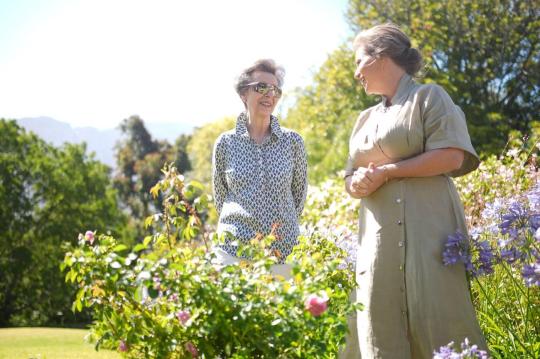
Tuesday 21st January
Today, The Princess Royal conducted her first day of engagements in South Africa.

The Princess Royal’s first visit in South Africa was the South African Riding for the Disabled Association (SARDA), which has provided free equine therapy, sport and training to the most vulnerable in society for the last 52 years. Her Royal Highness previously visited the organisation 30 years ago, on 25 November 1994.
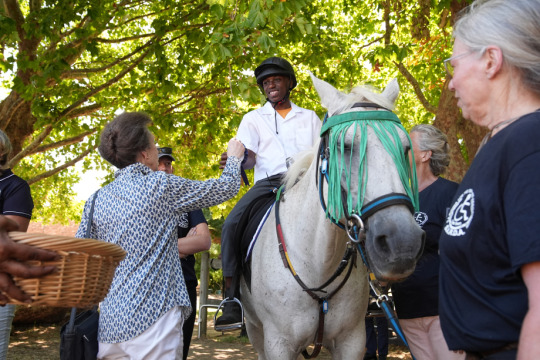
SARDA is the only remaining riding for the disabled training facility of its kind - it has served over 9,500 previously and currently disadvantaged children and their families.
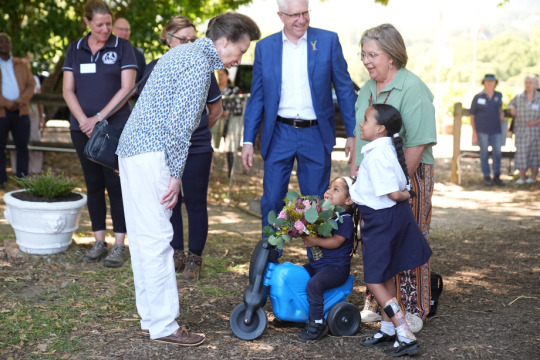
SARDA scholars have won 6 Gold, 2 Silver and 4 Bronze Medals at the Paralympics. Her Royal Highness is President of the Riding for the Disabled Association, becoming Patron of the RDA in November 1971, and President in March 1986.
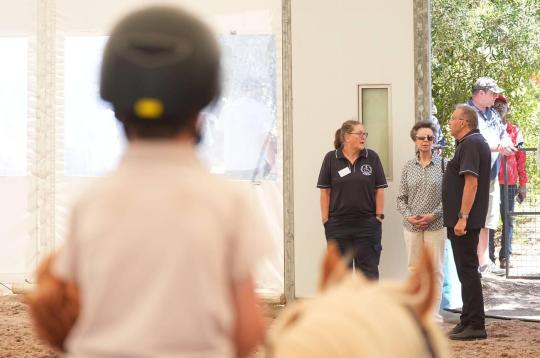
Later, The Princess Royal toured the British High Commission Residence Garden with Mr Leon Kluge, gold winner at the 2024 Chelsea Flower Show with Cape Floral Kingdom, and Mr Bulelani Bashe, Head Horticulturist at Grootbos Foundation.
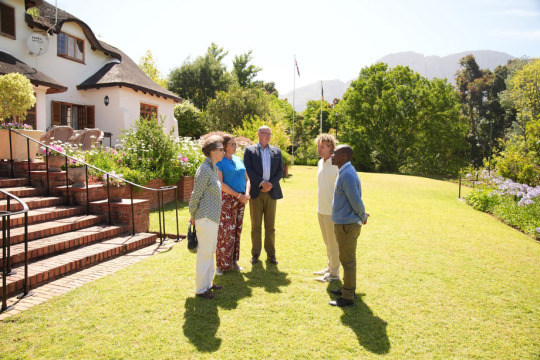
The Foundation works to conserve the environment of the Cape Floral Kingdom and to develop sustainable livelihoods through ecotourism, education, enterprise and sports development.
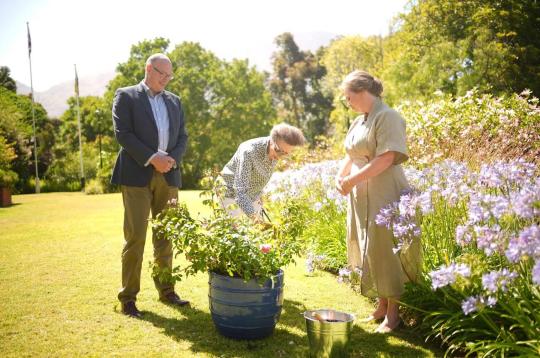
Her Royal Highness planted a Princess Anne Rose in the Residence Garden to symbolise the visit.
Wednesday 22nd January
As President of the Commonwealth War Graves Commission, The Princess Royal began the day at the Commonwealth War Graves Commission (CWGC), where she unveiled the Cape Town Labour Corps Memorial.

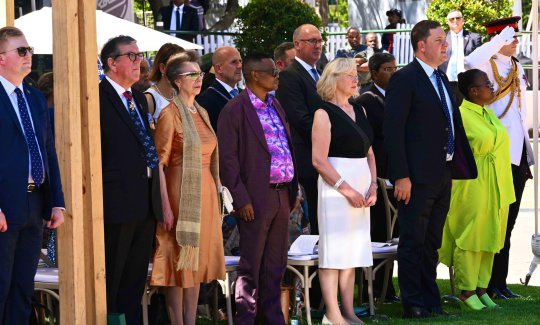
The new memorial, which honours the contribution of South African military labourers in the First World War, is part of the CWGC’s commitment to ensuring all those who died in the two World Wars are commemorated equally.
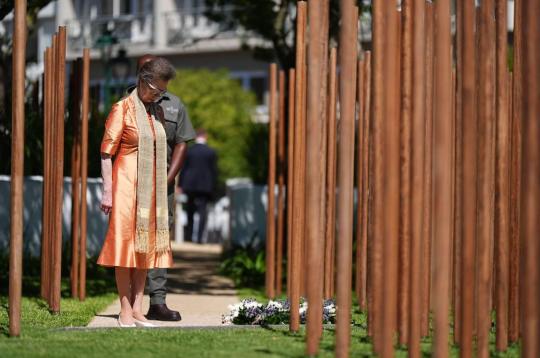

Following this, Her Royal Highness visited the Desmond and Leah Tutu Legacy Foundation. Here, The Princess Royal heard about the life and work of Archbishop Tutu, his role in supporting healing from discrimination and injustice, and how his legacy is being continued through the current work of the Foundation’s programmes.

On a tour of the Museum, The Princess Royal met staff members at stations throughout the ‘Truth to Power: Desmond Tutu & The Churches - In the struggle against apartheid’ exhibition. Her Royal Highness finished the tour by meeting young people and staff who are taking forward Archbishop Tutu’s legacy through the Leaders for Humanity programme.

Later, The Princess visited the Royal Cape Yacht Club, where she learnt about the work of The Royal Cape Sailing Academy, an organisation that empowers young people to development their skills through sailing.

The Academy teaches young people from some of the most under resourced communities how to sail, thereby developing self-confidence and leadership skills. Her Royal Highness met previous participants from the Cape 2 Rio Race including Jennifer Webb, who was sunk by a whale during the race in 1971.

The Princess Royal also visited the South African Astronomical Observatory (SAAO), where she toured the observatory and had an in-depth look at the McClean Telescope. The SAAO is the South African national centre for optical and infrared astronomy and is the foremost establishment for optical astronomy across the African continent.

Her Royal Highness met and heard from those who work within the observatory and learnt a little about the Southern African Large Telescope (SALT), the largest optical telescope in the southern hemisphere, which SAAO owns and bears operational responsibility for.

Finally, The Princess Royal visited a Thuthuzela Care (TCC). TCCs are intended to be a safe space for survivors of sexual assault, providing one space where individuals can receive counselling, medical and legal support without having to recount their experience to multiple agencies, thereby avoiding secondary traumatisation.
Her Royal Highness met the team delivering support in the centre, which is open 24 hours a day, seven days a week.
© Royal UK
#🥰🥰🥰#TOO BAD TIMMY WASN'T THERE#WE'VE BEEN ROBBED ONCE AGAIN 😭#I hope he's ok 🥺#princess anne#princess royal#brf#british royal family#workanne
34 notes
·
View notes
Text
#OTD in 1882 – Birth of republican activist, Joe Clarke, in Dublin.
Born in Rush, Dublin, Clarke worked for the Sinn Féin Bank, and was active in the Easter Rising. Located in the vicinity of Northumberland Road and Mount Street Bridge, he took part in some of the fiercest fighting of the week, in an area where the Sherwood Foresters famously marched into a waiting party of Volunteers, who had taken up strategic positions in the hope of ambushing men marching…

View On WordPress
#Éamon De Valera#Éamonn MacThomáis#Brian O’Higgins#Comhairle na Poblachta#Dublin#Easter Rising#Elizabeth O&039;Farrell#Frongoch Internment Camp#Irish Republican#Joe Clarke#Liverpool Prison#Michael Collins#Mount Street bridge#National Graves Association#Northumberland Road#Rush#Sinn Fein#Wakefield Prison
4 notes
·
View notes
Text
By: Elizabeth Weiss
Published; Jan 17, 2025
Biological anthropology and archaeology are facing a censorship crisis. Censorship can be defined simply as the suppression of speech, public communication, or information, often because it is deemed harmful or offensive. It can be enforced by government agencies or private institutions. Even self-censorship is increasingly prevalent, such as when an author decides not to publish something due to fear of backlash from their colleagues, or the belief that their findings may cause harm.
In these fields, censorship is primarily driven by professional associations like the American Anthropological Association (AAA) and the California Society for Archaeology, academic journals (often produced by these associations) such as Bioarchaeology International, universities, and museums, including the Smithsonian National Museum of Natural History. The focus of this censorship largely involves the suppression of images—including X-rays and CT-scans—of human remains and funerary objects, which are artifacts found in graves.
Biological anthropologists, such as bioarchaeologists (who study human remains from the archaeological record), have historically used photos and X-rays of skeletal remains and mummies to explore disease patterns of past peoples, teach new methods of age estimation and sex identification, and attract new students to the field of biological anthropology. Archaeologists use photos of artifacts to facilitate comparisons with other artifacts, aid in reconstructing past cultures, and explore topics like the peopling of the Americas, prehistoric trade patterns, and the emergence of new technologies. These are just a few of the many ways images have been used in the field.
Yet, in recent years, the use of photos of human remains and artifacts has faced increasing censorship. For example, the guidelines of the Society for American Archaeology (SAA) and its journals state: “Out of respect for diverse cultural traditions, photographs of full or explicit human remains are not accepted for publication in any SAA journal.”
Additionally, they add that “line drawings or other renderings of human remains may be an acceptable substitute for photographs.” In other words, they also may not be acceptable! So, the photo on the left would definitely not be accepted in SAA journals, and the image on the right may or may not be accepted.

In conference bookrooms, books featuring covers with photos or realistic images of bones are now being rejected for display. Ironically, just ten years ago, my cover photo from Paleopathology in Perspective: Bone Health and Disease through Time was so popular that someone stole the poster from the SAA conference bookroom. Just three years later, however, the SAA wouldn’t allow my publisher to buy advertising space using the cover of my book Reading the Bones: Activity, Biology, and Culture. Now, even realistic images of human remains are shunned! Somehow, I doubt my latest book, On the Warpath: My Battles with Indians, Pretendians, and Woke Warriors, will make it into any anthropology or archaeology conference bookrooms either!

Southeastern Archaeology, the journal of the Southeastern Archaeological Conference, has implemented a policy that it “will no longer publish photographs of funerary objects/belongings.” This is an expansion of their previous policy against publishing photographs of human remains. They now add that “in lieu of photographs, authors may choose to include line drawings or other representations of funerary objects/belongings.” This decision was initially made without member input, leading go backlash against the decision. However, after a discussion and a vote, the censorship was upheld. Majority rule is no way to run a scientific organization—which should be done on adherence to the principles and methodologies of science!
Not to be outdone by the southeastern archaeologists, the Society for California Archaeology (SCA) declared that “NO depictions of the remains of any specific person, regardless of ancestry, are to be included in any presentations, including photographs, drawings, X-rays, 3-D models, etc.” So, forget displaying any historic figures such as the mummy of Lenin, the death mask of Ishi, or the skeletal remains of Joseph Merrick (also known as the Elephant Man, who taught many people that physical deformity does not equate to a lack of intelligence). This restriction even extends to individuals like Jeremy Bentham, a professor from London College, who explicitly requested his preserved body be displayed, illustrating the breadth of these new policies. All of these and many others are now strictly off limits!

While banning photos, the SCA does permit the use of “[d]iagrams of generic skeletons, bones, teeth, or other body tissues.” Additionally, at their conferences, “[a] caution symbol will be placed next to all presentations discussing human remains in the program and on signage outside the door of the session so that those who wish to avoid this subject matter can easily do so.” Is education truly about avoiding uncomfortable information and materials?
The AAA’s Commission on the Ethical Treatment of Human Remains has ruled that images and digital materials must be treated as parts of bodies—and, thus, not published in any public spaces, including on social media. They state:
The use of images and any other digital materials (e.g. maps or GIS) derived from human tissues or Ancestral remains should be considered as part of the respectful treatment of those whose actual remains are used. This treatment acknowledges that their use should be restricted to defined (and consented) purposes, and that such use should remain confined to a protected, nonpublic space (and should never be displayed on social media or other non-password protected internet sites, including educational sites, and museums).
In other words, even maps constructed with DNA information are now subject to restriction!
They also plan to require members to take an “ethics pledge” to join or renew their membership. This is to ensure that no one goes rogue and shows a human bone in a place where someone might actually see it.
Journals that once served as valuable resources for understanding bone pathology (or disease) are now discarding the most important tool of all—images. Bioarchaeology International now demands “explicit recent permission” from descendants for the use of photos or images of human remains, even if the image were taken before these requirements and had been previously published (often on multiple occasions). These are referred to as “legacy images.” The journal further states that “if no permissions are forthcoming, the manuscripts are not considered for review.” Bioarchaeology International is not alone in censoring the use of legacy images; nearly all peer-reviewed anthropology and archaeology journals now enforce a similar policy.
One exception is the American Association of Biological Anthropology, which publishes the prestigious American Journal of Biological Anthropology. This organization specifies that the requirement to obtain permission for images and data of human remains applies only to new data; “legacy data is not included.” One wonders how long these comparatively ‘courageous’ holdouts will last before caving in. Currently, they have a committee developing a policy on human remains.
The International Journal of Paleopathology specializes in case studies of rare pathologies, where photos are essential to conveying information. The editorial board acknowledges the usefulness of photos, but they also state that:
While careful description of pathological lesions is essential to research in paleopathology, authors are encouraged to consider whether photographs of human remains are critical to the presentation of the research. If not essential, out of respect for descendent communities, they should be replaced with drawings or included as supplementary material. Authors may wish to consult the editor regarding these issues.
Can a line drawing really do justice to the complex and intricate changes that occur on skeletons due to diseases like osteomyelitis (bone infections), osteoarthritis, cribra orbitalia (a sign of anemia), or the various forms of dental disease seen sometimes in a single individual?

Beyond this censorship, institutions are also toeing the ideological line to exclude images of human remains. In September 2023, Penn Museum decided that its inventory would not include such images. And, the renowned Mütter Museum of the College of Physicians of Philadelphia, which aims to educate the public about anatomical medicine and health, has removed all images of human remains from its online database. This includes the image of Carol Orzel, who had specifically wished that her body be displayed to educate others about fibrodysplasia ossificans progressive, the painful, debilitating, and fatal bone and cartilage disease she suffered from.
The Santa Barbara Museum of Natural History issues a warning to anyone who might find human remains: “Never take photos of human remains in our region; that is culturally inappropriate here.” But Santa Barbara is a region that encompasses many cultures, including some Central Mexican communities who do not view photographing human remains as inappropriate, as they celebrate their ancestral past by displaying the dead. For example, Lisa Holtzover and Juan R. Argueta note in their 2017 article that in the central Mexican town of Xaltocan, indigenous residents support archaeological research and the exhibition of ancient human remains. Yet, North American academics often criticize their cultural preferences, even while they claim to be decolonizing the field. In their blind adherence to wokeism, academics’ patronizing “we know best” approach towards indigenous peoples who deviate from their narrative exemplifies a white savior complex. Ironically, those who claim to oppose racism in their quest for wokeism are themselves perpetuating it. What next? Should we give Egyptian mummies a Christian burial in the name of decolonization?
Universities, especially in California, have also imposed complete moratoria on the use of human remains images. For example, on August 30, 2023, California State University Bakersfield’s president issued a moratorium that stated:
[T]he university is placing a moratorium on the research, teaching, display, imaging, and circulation of human remains and cultural items (including archival material, notes, movies, and data) that are potentially subject to NAGPRA and CalNAGPRA.
Similarly, on March 26, 2024, the president of California Polytechnic Pomona issued a memorandum stating:
Cal Poly Pomona will consult with Tribes prior to access, use, distribution or display of potentially sensitive or proprietary information. This includes but is not limited to images, renderings, and reproductions of ancestral remains and cultural items that are or have been in a university’s collection.
The universities are dressing up their actions as compliance with national and state reburial laws, yet these laws do not yet ban the use of images. And, from the look of anthropologists’ self-censoriousness and the acts of university presidents, new laws are likely not even necessary to restrict scientific research and educational efforts.
But this isn’t just a US problem. For instance, Uppsala University in Sweden advises that “photographs of human remains from indigenous ethnic groups are not normally to be published.” Similarly, the National Museum of Scotland has put out a statement that “All images of human remains except those that are wrapped have been removed from our online collections database.” At the Smithsonian National Museum of Natural History, this policy resulted in the absurd covering up of a mummy that was wrapped because of the photo behind the mummy contained images of skulls from a forensic collection.

One may wonder what has led to such vast censorship. Progressive anthropologists have decided that images—and, in some cases, data—from human remains and funerary objects cause harm to indigenous peoples. They adopt the narrative from indigenous activists that these images are dangerous, rather than explaining the importance of research and dispelling the notion that societal ills like alcoholism, missing women and children, and poverty stem from evil spirits roaming the earth and wreaking havoc on their lives.
For instance, in a 2020 book chapter on digitizing anthropological collections, Laure Spake and colleagues, citing the Smithsonian’s collaboration with the Tlingit, stated, “the disturbance of Ancestors and their belongings can result in physical danger for the living.” Ironically, the authors used this argument to advocate for 3D scanning and creating replicas to allow for the rapid reburial of human remains as quickly as possible—a viewpoint that is now considered outdated!
At a Native American Graves Protection and Repatriation Act meeting on January 5, 2023, there was a discussion on the deletion of digital data. Even non-fungible tokens (NFTs) were discussed, although those discussing them didn’t even know what they were. During the meeting, Hawaiian Native activists argued that it’s possible to “entice the spirit of someone to inhabit” photos, digital data, and replicas, which they assert can be harmful. Consequently, the tribe opposes making scans and casts.
Larry Zimmerman and Margaret Conkey, in their 2024 article for the SAA Record, argue that control over photos and data should belong to Indigenous communities because it is “respectful” to believe their feelings of harm. In their words, “when someone tells you that what you are saying or doing hurts them and you truly respect them, you will make every effort you can to eliminate or at least to understand the cause of the hurt.”
Furthermore, in the 2024 AAA Ethical Commission on Human Remains, Sabrina Agarwal and her colleagues repeatedly imply that harm will come to descendent communities from research. The term “harm” actually was mentioned 44 times, including in the statement:
As an ethical approach to ethical solutions, the Commission chose to meet with representatives of those most affected by anthropological work with ancestral remains to learn their assessments of how they might be harmed or protected from harm when research and education is considered.
In a 2020 article in Sapiens, Chip Colwell wrote that “photographs of human are problematic because of specific cultural beliefs.” He elaborates that the Navajo, for instance, believe encountering spirits of the dead can sicken those who see them. He helpfully then adds that photos are more harmful than line drawings, 3D scans, or casts.
Also in 2020, Deborah Thomas, then the editor-in-chief of American Anthropologist, selected a photo of Margaret Mead with skulls for an issue featuring a special section on the anthropology of global white supremacy, complete with a republished conversation between Mead and James Baldwin. The image sparked a social media uproar and was said to be violent, racist, and harmful to indigenous and black communities. Thomas, agreeing that the image produced trauma, changed the cover and issued a groveling apology, which included the statement that “We know the role that anthropology has played in the erasure of Indigenous peoples in the Americas through its salvage/savage ethnography project and its continued use of human remains for ‘research’ purposes.”
Unfortunately, by leaving anthropology and archaeology devoid of images of human remains and funerary objects, we will learn less about the past. Legacy data will not be allowed for comparative research, and our next generation of forensic anthropologists will be poorly trained. More troubling is that non-scientists who attribute normal human variation to supernatural or alien influences will continue to captivate young minds with sensational images, drawing them towards pseudoscience instead of a genuine scientific understanding of the world.
Moreover, we should not expect censorship in anthropology and archaeology will be limited to new publications featuring human remains. I have no doubt that woke academics and publishers will start to remove previously-published materials. For example, the University of Florida Press deleted the images from my blog post, “Human Variation: More Than Skin Deep!”—which was intended to promote my book Reading the Bones—two years after its initial publication on their blog.
What is the solution for anthropologists? Woke anthropologists suggest a different mindset is needed. Zimmerman and Conkey argue that archaeologists will be required to abandon “cherished ideas like academic freedom” and “relinquishing complete control, ownership, or even stewardship of excavated materials” to continue working in the field. Additionally, the AAA Commission on the Ethical Treatment of Human Remains would also like to curtail our desire for academic freedom. They write, in a scolding tone, that “Academic freedom is not synonymous with ‘unrestricted access.’ Scholars, educators and museum curators must be responsible to descendants’ concerns for the dignified treatment of their dead.”
Once academic freedom is relinquished and the data—images and all—are in the hands of activist descendant communities, don’t expect new scientific discoveries. Instead, expect woke fairy tales arising out of victim narratives.
Censorship (and self-censorship) of images should not be seen as an isolated issue. It’s symptomatic of a wider pathology afflicting the field. Anthropology is dying. But when it’s finally dead, don’t expect to see a picture of the body!
--
About the Author
Professor Emeritus of Anthropology at San Jose State University and National Association of Scholars Board Member. Author of On the Warpath: My Battles with Indians, Pretendians, and Woke Warriors.
==
This is unabashed corruption.
Any organization or institution which implements policies like this must be stripped of all government (i.e. taxpayer) funding. You don't get to implement ideological dogma when the taxpayer is paying for it.
#Elizabeth Weiss#anthropology#archaeology#academic corruption#ideological corruption#woke dogma#wokeness#cult of woke#wokeism#wokeness as religion#woke#academic freedom#corruption#religion is a mental illness
29 notes
·
View notes
Text









The Princess Royal’s Official Engagements in September 2024
01/09 unofficial With Sir Tim Attended a church service at Crathie Kirk. ⛪️🏴
10/09 As Colonel-in-Chief, visited The King's Royal Hussars at Aliwal Barracks in Tidworth, Wiltshire. 🪖
Sir Tim represented Princess Anne at a Service of Thanksgiving for Sir Clive Johnstone (National President of the Royal British Legion) which was held at St. Margaret's Church in Westminster, London. 🌹
11/09 Visited Estuary Services Limited and named a Pilot Vessel in Ramsgate Royal Harbour, followed by a Reception at Royal Temple Yacht Club. 🍾🚤
As Patron of the English Rural Housing Association, opened a new development at Carpenters Yard in Shepherdswell near Dover, Kent. 🌳🏠
12/09 As Patron of Citizens Advice Scotland, visited Penicuik Citizens Advice Bureau. ⚖️
As Patron of the International Sheep Dog Society, attended the International Sheep Dog Trials at Syde Farm in Lanarkshire. 🐑🐕
Unofficial Sir Tim attended the launch of the Bradford UK City of Culture 2025 🏙️
13/09 Attended the Southampton International Boat Show. 🚤
As Patron of the National Museum of the Royal Navy, visited the Fleet Air Arm Museum at Royal Naval Air Station Yeovilton in Ilchester, to mark its 60th anniversary. ✈️⚓️
As Patron of Save the Children UK, attended a Concert at Cheap Street Church in Sherborne, to mark 30 years of support from the Cambridge Choral Scholars. 🎶
16/09 As President of Victim Support, visited the Bristol Service at St Werburghs Community Centre, to mark its 50th anniversary. 🤝
As Patron of Gloucestershire Rugby Football Union, attended the Annual Volunteer Awards Reception at Lockleaze Sports Centre in Bristol. 🏉
17/09 As Colonel-in-Chief of The Royal Logistic Corps, visited the Joint Helicopter Support Squadron at A Hangar in Royal Air Force Benson. 🚁
As Patron of the National Transport Trust, attended the Annual Awards Ceremony at Fawley Hill Museum, in Henley-on-Thames. 🏆
As Royal Patron of the National Coastwatch Institution, attended a 30th anniversary reception at the Corporation of Trinity House. 🍾
18/09 As President of the UK Fashion and Textile Association, visited ApparelTASKER Sustainable Garment Manufacturer in London. 👕👖
20/09 As Patron of the Beef Shorthorn Cattle Society, attended a Members' Development Day at Podehole Farm in Thorney. 🐮
21/09 Unofficial With Sir Tim Departed from Kemble Airfield and arrived at Amsterdam Airport Schiphol. ✈️🇳🇱
With Sir Tim Attended a Reception at the Airborne Museum Hartenstein, to commemorate the 80th anniversary of the Battle of Arnhem. 🪂
22/09 With Sir Tim As President of the Commonwealth War Graves Commission, attended the Annual Service of Commemoration at Oosterbeek Airborne Cemetery. 🪦🌹
With Sir Tim Visited the house of “the Angel of Arnhem” in Oosterbeek. 🏠👼🏻
Unofficial With Sir Tim, departed from Amsterdam Airport Schiphol and arrived back at Kemble Airfield. ✈️🇬🇧
24/09 As President of the Scotch Chef’s Club, visited Hugh Black and Sons Limited in Stirling. 🥩🏴
As Patron of the Royal Highland Education Trust, attended a Food and Farming Day at Solsgirth Home Farm in Dollar. 🎓🚜
As Patron of Opportunity International United Kingdom, held a Dinner at St James’s Palace. 🌍 🍽️
25/09 On behalf of The King, held an Investiture at Windsor Castle in the morning and afternoon.
26/09 As President of the Commonwealth War Graves Commission, inaugurated the Loos British Cemetery extension and attended a Reburial Service of Unknown Soldiers. 🇬🇧🇫🇷🪦
Attended a Reception at the Town Hall, Place de la République in Loos-en-Gohelle, France. 🇫🇷🥂
As Patron of Sense International, attended a Dinner at Church House, Westminster, to mark the 30th anniversary of the charity. 🦯🦻🎂
27/09 Opened Hull Trinity House Academy in Hull, East Yorkshire. 🏫
As Patron of the Sailors’ Children’s Society, presented awards at the “Anchor of Celebration” ceremony at Hull Trinity House. 🏆⚓️
As Patron of the Spinal Injuries Association, attended a 50th anniversary reception at SIA House in Milton Keynes. 🦽🎂
30/09 With Sir Tim As Patron of the Minchinhampton Centre for the Elderly, visited Horsfall House, to mark its 30th Anniversary. 🏡🎂
As Colonel-in-Chief of The Royal Logistic Corps, visited the Gurkha Allied Rapid Reaction Corps Support Battalion to mark the redesignation of 170 Headquarters Squadron at Imjin Barracks. 🪖
Total official engagements for Anne in September: 33
2024 total so far: 313
Total official engagements accompanied/represented by Tim in September: 5
2024 total so far: 86
FYl - due to certain royal family members being off ill/in recovery I won't be posting everyone's engagement counts out of respect, I am continuing to count them and release the totals at the end of the year.
#princess anne#princess royal#tim laurence#timothy laurence#september 2024#unofficial engagement count 2024
35 notes
·
View notes
Text


Korean Confederation of Trade Unions (KCTU) Statement / December 7th, 2024
The People Power Party who blocked the impeachment is an accomplice in treason!
Dissolve the People Power Party now!
Today, on December 7th, the impeachment motion against President Yoon failed in the National Assembly due to insufficient votes, as members of the People Power Party collectively walked out. The People Power Party has turned its back on the people's wishes, effectively admitting their complicity.
More than one million citizens gathered in front of the National Assembly. They came together because they cannot forgive a president who declared martial law and aimed weapons at his own people. Despite the cold winter weather, they took to the streets hoping desperately for the impeachment to pass.
However, the news from the Assembly was shocking. The ruling party members simply walked out, refusing to even participate in the vote. They abandoned their duty to the people. Today, citizens witnessed democracy taking a step backwards. They saw clearly who stands with those who would harm our democracy.
The People Power Party must be dissolved. Those who protect Yoon must face consequences. It would be a grave mistake to think this can be resolved through compromise or constitutional amendments for an early resignation. Through the people's judgment, Yoon, his associates, and the People Power Party will face severe consequences.
25 notes
·
View notes
Text
Luke Taylor at The Guardian:
For Isabel Corro, Donald Trump’s suggestions that the US could use military force to take control of the Panama Canal evokes painful memories. The 79-year-old vividly recalls rushing her children inside her apartment on 20 December 1989 as US army helicopters and fighter jets screamed over Panama City, turning buildings to piles of rubble with rockets and gunfire.
Corro’s stepfather, a police officer, was killed in the invasion; his body was not found until it was hauled from a mass grave the following year. “I remember that night. The city was quiet, the houses full of decorations and the entire country was in anticipation of Christmas. Then suddenly, helicopters were whirring around and the sky was lit up with bombs and gunfire,” Corro said. “It was an extremely violent and tragic night. One that unfortunately I will never forget.” Washington had once backed then president Manuel Noriega – an ally who had spied for the CIA – but George HW Bush sent in 10,000 troops to oust the dictator as his role as an international drug kingpin became apparent. Hundreds of people were killed – many of them civilians – during Operation Just Cause and the shadow of the invasion still looms large over Panama. Trump’s comments have stoked fears the US could once again set its military sights on the country.
“He is a very arrogant man who thinks he can take whatever he wants,” said Corro, president of the Association of Family Victims of the 1989 US Invasion of Panama. “He cannot just decide: ‘I’m going to buy this country, I’m going to invade this one.’ The world is not some big flea market. It should not happen and we will not let it happen.” Trump, who will be sworn into office as US president on January 20, has returned to the subject of Panama frequently in recent weeks, complaining that American ships are charged “ridiculous” fees for passing through the canal, which he alleged was controlled by China.
[...]
In Panama, where the scars of conflict with the US are still healing, Trump’s comments have provoked widespread anger. The incident has strained relations with Panama’s government, which has said sovereignty over the canal is “non-negotiable” and accused Trump of lying about making an offer to buy it. “The only hands operating the canal are Panamanian and that is how it is going to stay,” said the country’s foreign minister, Javier Martínez-Acha. About 5% of global maritime traffic passes through the Panama Canal, slashing 6,835 miles (11,000km) off a journey that would otherwise require a long and dangerous trip skirting the southern tip of South America. The head of the Panama Canal Authority said on Wednesday that Trump’s suggestion that US ships get preferential rates “will lead to chaos” and denied that China had any control over the operation.
“We cannot discriminate for the Chinese, or the Americans, or anyone else. This will violate the neutrality treaty, international law and it will lead to chaos,” Ricaurte Vásquez Morales told the Wall Street Journal. The waterway was built by the US between 1904 and 1914, and leased to Washington. Following a treaty signed by then president Jimmy Carter in 1977, control of the canal was returned to Panama in 1999 under the condition it would be free for any nation to use.
The canal contributes 7.7% of Panama’s GDP and has become a cause for “pride” and part of “the country’s identity”, said Serena Vamvas, councilor for the San Francisco district in Panama City. “Panama might be divided politically but we all agree the canal is a national treasure. Everyone here is outraged by Trump’s comments,” Vamvas said. Any discussion of US intervention prompts painful memories for many in Panama. Officially, 300 soldiers and 214 civilians were killed in the 1989 invasion, but some rights groups say the death toll was closer to 1,000. Many Panamanians celebrated their country’s liberation from Noriega’s rule, but the US was accused of being heavy-handed, leaving a disproportionate number of civilians among the dead.
Donald Trump’s threats to retake the Panama Canal has reopened wounds within Panama, as memories of the 1989 US invasion still linger.
#Annexation of Panama Canal#Panama#Panama Canal#Donald Trump#Trump Administration II#Colonialism#US/Panama Relations#United States#Invasion of Panama#Manuel Noriega#Operation Just Cause
23 notes
·
View notes
Text

𝐉𝐎𝐇𝐍𝐍𝐘 𝐓𝐀𝐘𝐋𝐎𝐑
“Pain is temporary, but the scars tell my story.”
➤ BASICS
Name: Johnny Taylor DOB: 23 March 1998 Location: Notre Dame, IN, USA
➤ PROFILE
Full Name: Jonathan Ezekiel Taylor Nicknames: Johnny, John, JET Birthplace: Austin, TX, USA Hometown: Austin, TX, USA Nationality: American Occupation: Assistant Coach
➤ FAMILY
Father: Andrew Taylor Mother: Mary Anne Taylor (née Collins) † Siblings: Benjamin, Christian †, Jackson, Faith & Hannah Taylor Cousins: Ariel & Billie Wright Niece: Shea Carter (née Taylor)
➤ BACKSTORY
Jonathan, or better known to his family and friends as "Johnny" is the youngest of six. Born a full two decades after the eldest, Benjamin, Johnny would sometimes be referred to as "Benjamin 2.0", though not for their personalities. The two were their parents' favourites — a well-known fact neither parent has ever tried to deny. In reality, the two couldn't be more different. While Benjamin was the standard in which all the other Taylor children were measured, being the youngest gave Johnny a little more leeway that others never had — along with every advantage and disadvantage that came with that. Not only did Benjamin and Mary ensure that their "Golden Boy" had everything he needed to succeed, but he was also pushed to get a full scholarship to the University of Notre Dame where he played for the school's first-rate men's soccer team. Pushed until he was the highest scoring rookie in the team's history and the youngest MVP. Pushed until playing through a grave injury lost him everything.
➤ TEMPERAMENT
✓ down-to-earth, hardworking, jovial ✗ jaded, perfectionist, self-critical
➤ ARCHIVE
N01
DISCLAIMER This account is for roleplaying purposes only and is not associated with any individuals depicted herein. All written content are original works of fiction; any resemblance to existing works and/or characters should be considered coincidental and free of malicious intent. Please do not reproduce/redistribute. Thank you.
33 notes
·
View notes